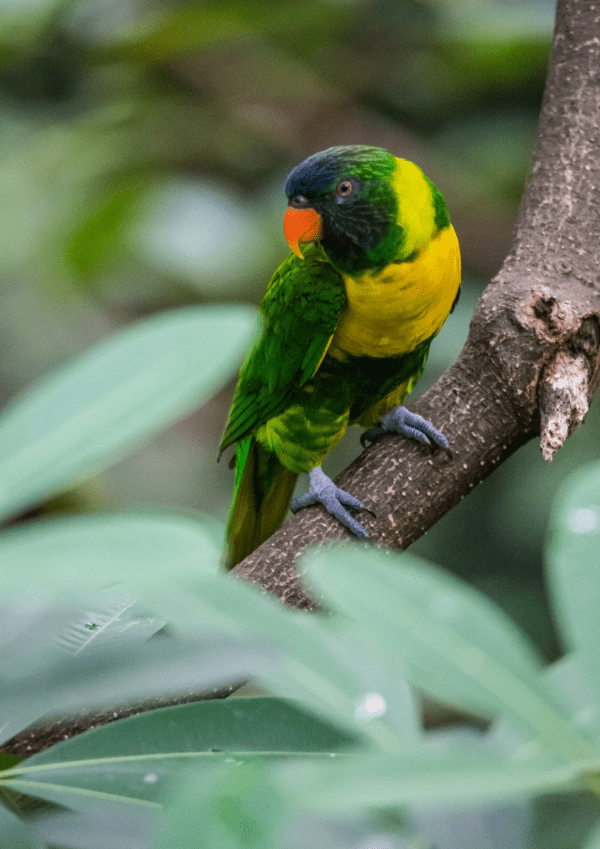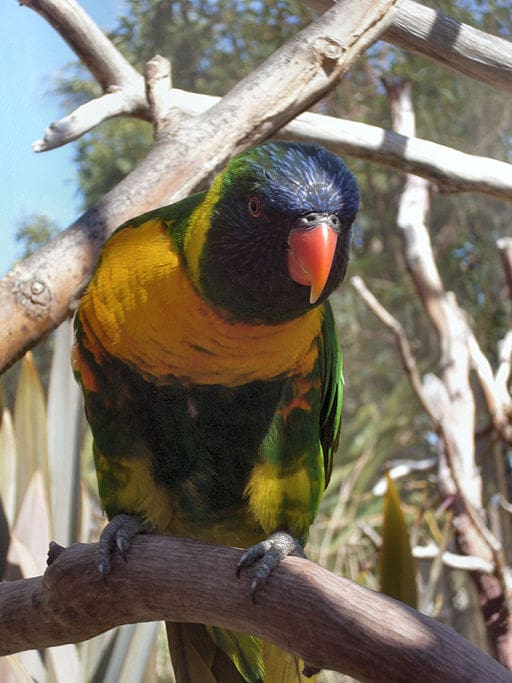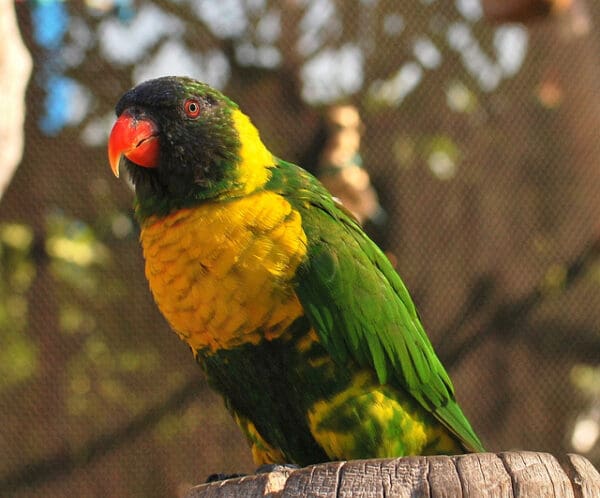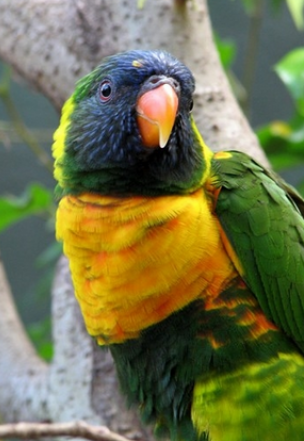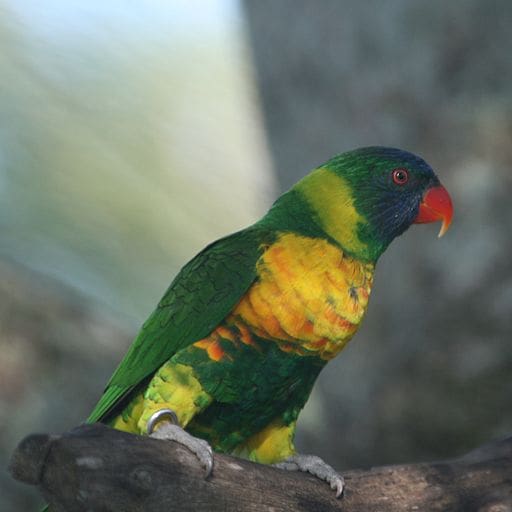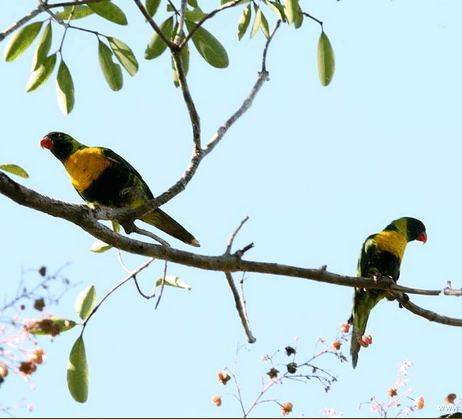Marigold Lorikeet
Also known as:
Sumba Lorikeet (T.c. fortis)
Also known as:
Sumba Lorikeet (T.c. fortis)
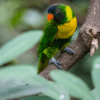
![© Goldie [CC BY 2.0] via Flickr A Marigold Lorikeet perches on a limb](https://parrots.org/wp-content/uploads/2023/01/wpt_Marigold-Lorikeet_2006-15-100x100.jpg)
![© Tracie Hall [CC BY-SA 2.0] via Flickr A Marigold Lorikeet perches on a stump](https://parrots.org/wp-content/uploads/2023/01/wpt_Marigold-Lorikeet_2006-14-100x100.jpg)
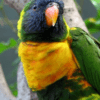
![© derivative work: Snowmanradio (talk) Matthew Hoelscher [CC BY-SA 2.0] via Wikimedia Commons A Marigold Lorikeet perches on a branch](https://parrots.org/wp-content/uploads/2023/01/wpt_Marigold-Lorikeet_2006-5-100x100.jpg)
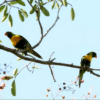
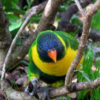
DID YOU KNOW?
The Marigold Lorikeet was once considered conspecific with Trichoglossus haematodus.

Trichoglossus

capistratus
Size:
26 cm (10 in)
Weight:
100-157 g (3.5-5.5 oz)
Subspecies including nominate:
three: T.c. capistratus, T.c. flavotectus, T.c. fortis
Colour Adult:
T.c. capistratus: Both adults green head with purple/blue streaking on forecrown to cheeks; breast pale yellow; collar wide and green; dark green abdomen; yellow underwing coverts with varying orange markings.
T.c. flavotectus: Both adults green head with purple/blue streaking on forecrown to cheeks; yellow to deep orange variability on breast; collar wide and yellow; dark green to green/black abdomen; yellow underwing coverts with varying orange markings.
T.c. fortis: Both adults black/brown head with purple/blue streaking on forecrown to cheeks; green lores, throat, line above to behind eye and occiput; bright yellow breast with no barring but with orange/red markings; dark green abdomen, with occasional blue/black tints; yellow underwing coverts.
Colour Juvenile:
As in adults.
Call:
Repeated notes, sharp, rolling while in flight. Shrill chattering while feeding. Soft notes at rest.
More Information:
Content Sources:
Wikipedia
BirdLife International
Cornell Lab of Ornithology/Birds of the World
Parrots of the World, Forshaw, 2006.
Parrots in Aviculture, Low, 1992.
Lexicon of Parrots, Thomas Arndt.
Captive Status:
Uncommon.
Longevity:
20 yrs in the wild, 15-25 yrs in captivity.
Housing:
Enclosure with drain in floor, or suspended cage over tiled or concrete floor.
Diet:
Nectar – a commercial type specially formulated for small species or a mix of baby cereal (lactose-free) and honey, malt extract or molasses, mixed with filtered water, made fresh once or twice daily, making up at least 40 percent of the diet; vegetables and fruit especially apple, pear, orange, cactus fruits and bananas, and one or more daily of: carrot, fresh corn, green leaves; plus dried figs soaked in water for a few hours, spray millet and a small amount of soaked or sprouted sunflower seed and small amount of canary seed.
Enrichment:
Loves bathing, hanging toys, puzzle/foraging toys, foot toys, ladders, swings, socializing; noisy toys (bells, squeakers), bird safe chewables (vegetable tanned leather, safe woods).
Nest Box Size:
L-shaped box, 51 cm x 36 cm (20 x 14 in).
Clutch Size:
2 to 3
Fledging Age:
8-9 weeks
Hatch Weight:
—
Peak Weight:
—
Weaning Weight:
—
World Population:
Unknown, decreasing.
IUCN Red List Status:
Least Concern
CITES Listing:
Appendix II
As conspecific with T. haematodus.
Threat Summary:
Not globally threatened. Numbers are unknown but are suspected to be in decline due to unsustainable levels of trade.
Range:
T.c. capistratus: Found on Timor.
T.c. flavotectus: Found on Wetar, Romang and Kisar Islands, northeast of Timor.
T.c. fortis: Found on Sumba, Lesser Sunda Islands.
Habitat:
Most common in lowlands but found up to 2400 m (7872 ft). Wide variety of areas including settlements, forest, coconut plantations, savanna, Eucalypt stands and mangroves.
Wild Diet:
Feeds mainly on nectar and pollen, especially Eucalyptus on Timor. Also recorded feeding on nectar of Erythrina flowers but will also take figs, insects and can be found around man-made feeding stations.
Ecology and Behaviour:
Found in mixed flocks with other parrots; in small noisy groups. Nomadic, as they are dependent on flowering trees. Roosts communally in groups of hundreds of birds. Will also roost and nest on the ground on some of the predator-free islands. Displays frequently.
Clutch and Egg Size:
2 to 3 ovate eggs, 27.0 x 22.5 mm (1 x 0.9 in).
Breeding Season:
August-October, Sumba. Nest is in tree hollow.
Related Links:
—
